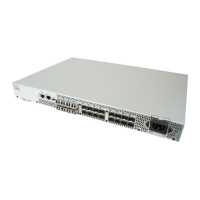Recommendations for cable management
27
Installing and Configuring the DS-300B
Recommendations for cable management
The minimum bend radius for a 50 micron cable is 2 in. under full
tensile load and 1.2 in. with no tensile load.
Cables can be organized and managed in a variety of ways: for
example, using cable channels on the sides of the cabinet or patch
panels to minimize cable management. Following is a list of
recommendations:
• Plan for rack space required for cable management before
installing the switch.
• Leave at least 3.28 ft (1 m) of slack for each port cable. This
provides room to remove and replace the switch, allows for
inadvertent movement of the rack, and helps prevent the
cables from being bent to less than the minimum bend radius.
• If you are using ISL Trunking, consider grouping cables by
trunking groups. The cables used in trunking groups must
meet specific requirements, as described in the “Data
transmission ranges” on page 53.
• For easier maintenance, label the fiber optic cables and record
the devices to which they are connected.
• Keep LEDs visible by routing port cables and other cables
away from the LEDs.
• Use Velcro straps to secure and organize fibre optic cables. Do
not use tie wraps on fiber optic cables, because wraps are
easily overtightened and can damage the optic fibers.

